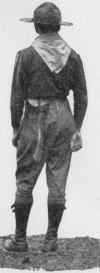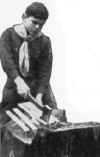By Peter McLaren
To Scout Masters I would say: "Encourage boys in the use of their scout axe. But first train them how to use it and where to use it. Instill in their minds that there are certain precautions to be observed, as there are in the use of a pen knife, or any other edge tool.
What would be more appropriate in scouting than a series of lessons on the care and use of the scout axe? What more fascinating than a series of contests to promote interest and efficiency? What is more stimulating than chopping rivalry in a patrol?
Chopping is an all-year-'round sport. In unseasonable weather, instructions may be given in meeting rooms, and demonstrations made on actual logs.
Certain standards of knowledge and skill should be set up, so that each boy will have some definite objective, some point of efficiency to which he can work by each time attempting to improve his own knowledge and skill.
Contests may then take the form of inter-patrol competitions, spreading later to troop competitions. There are various lines along which the contest theme could be developed:
A written competition could be held, after due study, on Playing Safe, as outlined in Chapter 4. Such a test would emphasize the necessity for care in using an axe, and would be an excellent groundwork for a course of instruction.
A second contest could be a test in efficiency in removing the axe handle without destroying it; refitting handle to the eye; hanging the axe correctly; wedging it tightly; sharpening blade with a file and honing with a stone, as outlined in Chapter 2.

Fig. 55.
Proper hang for Plumb
Official Scout Axe. Always check up this hang each time the axe is refitted.
And a third-spotting on a map (or describing locations of) five specimens of standing timber which should be removed to improve the appearance of a woods, or to benefit growing trees. See Chapter 1.
Then the actual use of the tool could be introduced, along the following lines:
Cutting off twigs and saplings as a demonstration of axe skill. Points to be considered: Number of strokes; cleanness of cut, and the point at which severed.
Demonstrating ability to cut off a hanging branch close to limb or trunk of tree, so that bark will grow over and heal the cut.
Scaling bark from an appropriate log. Points to be scored would be: The time consumed; the correctness of method used, and condition of bark after removal.
Many other forms of competition will suggest themselves to the Scout Master. And all of them serve the twofold purpose of increasing the boy's store of useful facts, and of giving him mastery over the axe.
The scout axe is just a miniature of the man's chopping axe. Many of the points discussed in this book apply as well to the scout axe as to the man's axe, especially the safety precautions.
Refitting the Scout Axe. This is illustrated and described with a large axe on pages 28, 29 and 30 and may be adapted to the scout axe.
The "Hang." To hang a scout axe properly, make a mark in the center of your handle eight inches from the eye. From this mark, the distance to the heel of the axe blade should be eight inches also. See Figure 55.
Sharpening and Honing. This is discussed in complete detail in Chapter 2. The only variation from these instructions, when filing a scout axe, is to file the flat of the blade back only about two inches instead of three, and to roll the bevel only one-fourth of an inch, instead of a half-inch.
Scouts! Keep your axe sharp. It is the dull edge that glances off the wood and becomes dangerous. A sharp axe bites in where you aim it.
Always keep your axe in its sheath when not in use. This is not only a safety measure, but it also protects the edge from being nicked, and prevents rusting. Do not put the blade near a fire or you will destroy its temper.
The proper position for carrying the axe on the belt is over the left hip, and not at the side. See Figure 56.

Fig. 56.
Proper
position for carrying Scout Axe on belt.
Do not crowd your work. Stand clear, with a free striking distance for the axe as shown in Figure 57.

Fig. 57.
Keep clear of your work to
permit a free, easy swing of the axe.
Have a clear circle around the spot you are chopping equal to the distance of the axe held at full arm's length. See that it is free of vines, sticks, etc., which might deflect your axe. Stay at a safe distance from other boys, so that flying chips, or a misdirected blow will do no damage.
Do not use your axe for driving an iron wedge. You are likely to chip or mash the head.
When chopping a limb from a tree, or a branch from a limb, always cut from the underside as shown in Figure 1 on page 8. It is easier on the axe because you are cutting with the grain, and it leaves a smooth joint over which the bark will grow. Never cut into the crotch. .
Always cut sticks, etc., at an angle, when cutting across the grain. Never drive your axe straight in. It makes for harder chopping and dulls the edge. By chopping at an angle, you follow the grain and cut faster, with less effort. See Figure 58.
 Fig. 58.
Fig. 58.
Chop at an angle.
Never drive the axe in straight.
When cutting sticks across the grain, support the sticks on solid wood, and strike at an angle as described above. At the same time that the axe bites into the wood, tilt the axe head sharply so that it pins down the loose piece and prevents it from flying. See Figure 58.
When chopping boxes for firewood, lay the board flat upon some solid wood support, hold it by the side and strike your blows as shown in Figure 59, chopping with the grain, of course.

Fig. 59.
The safe method of cutting box wood for building a fire.
No danger to the hands.
When chopping stakes, lay the stake on a solid object in the same way, and strike it as shown in Figure 60.

Fig. 60.
A safe way to cut stakes.
The end of the board, where the axe strikes,
is supported by solid wood.
Or beginners may find it easier to use the method illustrated in Figure 61. Here the stake is placed on the far side of a log, and a misdirected or glancing blow will fall harmlessly upon the log.

Fig. 61.
This meth od for beginners,
eliminates all risk from glancing blows.
Keep your axe head tight always. The Plumb Official Axe can be retightened by turning the patented Screw Wedge, as shown in Figure 62.

Fig. 62.
The head
of the Official Plumb Scout Axe ca n be kept tight just by turning the patented
screw wedge.
When chopping live shoots to clear away underbrush, bend the shoot over. This gives a resiliency to the wood and enables the axe blade to cut it off more easily.
When handing your axe to another, grasp it firmly by the head with the edge towards you, and insist that the boy receiving it grasp it by the head. Do not hold out the handle to him, as in a careless moment he may grasp it loosely in his hand, and the weight of the head will carry the tool down sharply towards his legs.
Stripping Bark. First, cut through the bark in a straight line from one end of the log to the other. Then start at one end and work the blade underneath the bark. Use the handle as a lever to lift the blade and loosen the bark. Progress down the log in this manner. Return to the top and begin again, inserting the axe deeper. Do not attempt to loosen too great an area at one time, or the bark will crack, but continue your progress from end to end of log until you have gone all the way around it.